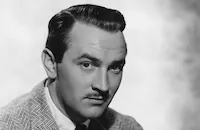Married Bachelor

Brief Synopsis
Cast & Crew
Edward Buzzell
Robert Young
Ruth Hussey
Felix Bressart
Lee Bowman
Sheldon Leonard
Film Details
Technical Specs

Synopsis
On a train on which Norma and Randolph Haven must hastily leave town to avoid bill collectors, Norma advises her husband to try something different and get a real job instead of being involved in another scheme. Randy promises to reform, but in New York City, he secretly becomes partners with "Cookie" Farrar in a bookie operation which fronts as a collection agency. Meanwhile, Norma has been working happily at the glove counter of a department store and planning their life together. Ashamed of himself, Randy decides to get a real job, but on the same day takes a $1,000 bet from gangster Johnny Branigan, who is backing a horse that Cookie thinks cannot win. Unfortunately, the horse wins at seventeen-to-one and Randy doesn't have the money to pay off. Trying everything to raise money, Randy and Cookie go to Professor Ladislaus Milic, who owes them $330, but can only pay if he publishes one of his books. Randy settles for rights to The Neurological and Physiological Effects of Marriage , puts his own name on the title page, and, through a ruse, gets publisher Eric Santley interested in the book. That night, just as Branigan is threatening Randy, Eric calls to say that he wants to publish the book and offers a $500 advance. The promise of more money helps to stall Branigan, who takes the terrified Cookie as a "deposit" on the $17,000. Although Norma is furious to discover that Randy has been a bookie, he sincerely promises that he will reform and she forgives him. The next morning, Eric enthusiastically signs a contract with Randy, whom he assumes is unmarried, and says that he is going to retitle the book and promote it as A Bachelor Looks at Marriage . Eric also gets Randy a radio show to dispense advice to troubled couples. Now realizing that Randy can pay back all the money, Branigan agrees to go along with the scheme. That night, after Norma sees a newspaper article promoting the book, she informs him that "bachelors" sleep on the couch. As the weeks pass, the book becomes a bestseller and Randy becomes a sensation. He rents a new penthouse apartment, but Norma decides to stay at their old place. A short time later, Norma goes to hear Randy give a lecture and decides to follow his advice that women should be free to form friendships with men. At the same lecture, Norma meets Eric, who is immediately attracted to her. That evening, Eric asks Randy for advice on how to romance a woman, and Randy complies, not knowing that Norma is the woman in question. When Eric asks Norma to accompany him to a party at which "Dr. Havens" will be present, she agrees, and Randy is stunned to see that she is Eric's date. Later that night, Randy goes to their old apartment but leaves after Norma tells him he has changed. Some time later, Norma goes to Milic asking for advice on how to save her marriage and get the old Randy back, and he advises her to give Randy an ultimatum: her or his new reputation. That night, at the radio broadcast, Norma shows up as one of the evening's "problems," much to Randy and Eric's surprise. When she obliquely presents her story, the radio audience's "jury" says that she should divorce her husband. She and Randy then start to argue, and everyone suddenly everyone knows that they are talking about themselves. Finally realizing that he loves Norma more than success, Randy embraces her as the audience cheers and is soon traveling with her on another outward bound train.

Director

Edward Buzzell
Cast

Robert Young

Ruth Hussey

Felix Bressart

Lee Bowman

Sheldon Leonard

Sam Levene
Murray Alper

Roy Gordon
Douglass Newland
Charlotte Wynters

Hillary Brooke

Joe Yule
Henry Sylvester
Joe Whitehead

Connie Gilchrist
Don Brodie
Hal Lesueur
Mimi Doyle

Natalie Thompson
Inez Cooper

Bess Flowers

Charles Irwin
Lulu Mae Hubbard
Gladys Blake
Sergei Arabeloff
Gayne Whitman
Ernest Whitman
William Haade
Charles Ray
Frances Carson
Edwina Coolidge
Kay Linaker
Sheila Darcy
Crew
John W. Considine Jr.
George Folsey
Cedric Gibbons
Sydney Guilaroff
Lennie Hayton
Kalloch
Harold Kress
Ben Lewis
Harry Mcafee
Sandy Roth
Dore Schary
Manuel Seff
Douglas Shearer
Norman Taurog
Sam Taylor
Edwin B. Willis

Film Details
Technical Specs

Articles
Married Bachelor
By Richard Harland Smith

Married Bachelor
Quotes
Trivia
The film was pared down to 81 minutes from the preview running times of 87 and 85 minutes.
When director Edward Buzzell was sidelined with a cold, Norman Taurog temporarily took over as director, and Sam Taylor as assistant director.
Notes
The Film Daily review lists a preview running time of 87 minutes and the Daily Variety review lists a preview time of 85 minutes, suggesting that several minutes were cut from the film for its general release. According to a news item in Hollywood Reporter on August 8, 1941, Norman Taurog took over direction of the film while Edward Buzzell was ill with a cold, and Sam Taylor assisted him. Hollywood Reporter charts list only Harold Kress as the film editor, but the onscreen credits list only Ben Lewis. Although actress Hillary Brooks's character name in the CBCS is "Connie Gordon," in the film her character name is "Hillary."















